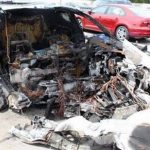Tesla Hit with Negligence Suit Following Fatal Car Crash in Fort Lauderdale
Edgar Monserratt is seeking monetary damages on behalf of his son Edgar Monserratt Martinez, who died in May 2018 while riding in a 2014 Tesla Model S. The complaint accuses the company of improperly removing a speed limiter placed on the car, as well as releasing an unsafe product.
January 11, 2019 at 02:53 PM
4 minute read
 A lawsuit has been filed against Tesla in connection with the death of Edgar Monserratt Martinez. Photo: Shutterstock
A lawsuit has been filed against Tesla in connection with the death of Edgar Monserratt Martinez. Photo: Shutterstock
Tesla Inc. has found itself under legal siege in South Florida in connection with a May 2018 car crash that left two dead and a 2014 Tesla S engulfed in flames.
A lawsuit filed Tuesday in Broward Circuit Court has accused the car manufacturer of negligence in the death of 18-year-old Edgar Monserratt Martinez. Martinez was in the front passenger seat of the Tesla S with driver Barrett Riley when the vehicle plowed into a wall at 116 mph. The collision, which took place on Seabreeze Boulevard in Fort Lauderdale, sent the car careening into the road before it eventually struck a metal light pole and stopped at a wall on the opposite side of the street. The vehicle burst into flames following the final impact, with Martinez and Riley still inside, Another passenger, Alexander Berry, was tossed from the vehicle, but survived.
“The fire turned into an inferno so quickly they had no opportunity to get out,” attorney Philip Corboy Jr. said. Corboy, a personal injury lawyer and partner at Chicago law firm Corboy & Demetrio, is one of the attorneys representing Martinez's family in the suit against Tesla. The complaint listed the deceased teen's father and mother — Edgar Monserratt and Esperanza Martinez — as the plaintiffs seeking monetary damages.
Read the lawsuit:
The complaint alleges the company was negligent in ensuring the safety of customers using the Tesla Model S. It describes the car's batteries as “inherently unstable and subject to explosion and spontaneous fire.” Corboy noted there have been numerous reports of fires consuming Tesla Model S vehicles due to complications with its batteries.
“There's a concept known as thermal runaway, and when one battery catches fire it spreads to everything around it,” the attorney said, pointing out the Tesla Model S holds hundreds of batteries in its two battery packs. Corboy said one of the batteries exploded upon the car's initial collision before more were damaged when the vehicle struck the east-side wall on Seabreeze Boulevard.
A Tesla spokesperson provided a statement expressing that the company's thoughts “continue to be with the families affected by this tragedy.”
“Unfortunately, no car could have withstood a high-speed crash of this kind,” the statement read. “Tesla's Speed-Limit Mode, which allows Tesla owners to limit their car's speed and acceleration, was introduced as an over-the-air update last year in dedication to our customer's son, Barrett Riley, who tragically passed away in the accident.”
 The remains of the Tesla vehicle Edgar Monserratt Martinez died in. Courtesy photo
The remains of the Tesla vehicle Edgar Monserratt Martinez died in. Courtesy photoBut the suit alleges Tesla was negligent in complying with requests made by the vehicle's owners, Riley's parents, James and Jenny. Although they had ordered a speed limiter to be placed on the car after Riley received a speeding ticket for driving 112 mph, the device, or governor, was not on the vehicle at the time of the accident.
“When [Riley] went to pick it up he told the Tesla people to take the governor off,” Corboy said. “Tesla didn't ask why, they said, 'Sure!'” The attorney said research has indicated it's not just collisions that have caused Tesla batteries to combust, and that the plaintiff might learn more in discovery. “It's a whole host of problems with Tesla, it's not just one,” he said. “Had this car not been able to go 85 mph, our engineers tell us it easily could have survived that road.”
Corboy pointed out Tesla had requested a patent for intumescent and fire-retardant coating for its batteries in 2009. Although the request was granted in 2010, he says the substance was ultimately not used.
 Philip Harnett Corboy Jr., partner at Chicago law firm Corboy & Demetrio. Courtesy photo
Philip Harnett Corboy Jr., partner at Chicago law firm Corboy & Demetrio. Courtesy photo“We're going to find out why,” he said. “The car wouldn't have caught fire and exploded the way it had if it used the intumescent material.”
In addition to Corboy, the plaintiff's legal team includes Scott Schlesinger and other attorneys from Schlesinger Law Offices in Fort Lauderdale.
Related stories:
Tesla Autopilot, Updates Leave Driving a Challenge for Broward Owner
Injured Orlando Man Sues Tesla Over Autopilot Feature, Crash
This content has been archived. It is available through our partners, LexisNexis® and Bloomberg Law.
To view this content, please continue to their sites.
Not a Lexis Subscriber?
Subscribe Now
Not a Bloomberg Law Subscriber?
Subscribe Now
NOT FOR REPRINT
© 2025 ALM Global, LLC, All Rights Reserved. Request academic re-use from www.copyright.com. All other uses, submit a request to [email protected]. For more information visit Asset & Logo Licensing.
You Might Like
View All
Tragedy on I-95: Florida Lawsuit Against Horizon Freight System Could Set New Precedent in Crash Cases
2 minute read

Securities Claims Against Lilium N.V. for Electric Plane Production Delays Fail to Take Flight, Federal Judge Holds
5 minute read
Trending Stories
- 1E-Discovery Provider Casepoint Merges With Government Software Company OPEXUS
- 2How I Made Partner: 'Focus on Being the Best Advocate for Clients,' Says Lauren Reichardt of Cooley
- 3People in the News—Jan. 27, 2025—Barley Snyder
- 4UK Firm Womble Bond to Roll Out AI Tool Across Whole Firm
- 5Starbucks Hands New CLO Hefty Raise, Says He Fosters 'Environment of Courage and Joy'
Who Got The Work
J. Brugh Lower of Gibbons has entered an appearance for industrial equipment supplier Devco Corporation in a pending trademark infringement lawsuit. The suit, accusing the defendant of selling knock-off Graco products, was filed Dec. 18 in New Jersey District Court by Rivkin Radler on behalf of Graco Inc. and Graco Minnesota. The case, assigned to U.S. District Judge Zahid N. Quraishi, is 3:24-cv-11294, Graco Inc. et al v. Devco Corporation.
Who Got The Work
Rebecca Maller-Stein and Kent A. Yalowitz of Arnold & Porter Kaye Scholer have entered their appearances for Hanaco Venture Capital and its executives, Lior Prosor and David Frankel, in a pending securities lawsuit. The action, filed on Dec. 24 in New York Southern District Court by Zell, Aron & Co. on behalf of Goldeneye Advisors, accuses the defendants of negligently and fraudulently managing the plaintiff's $1 million investment. The case, assigned to U.S. District Judge Vernon S. Broderick, is 1:24-cv-09918, Goldeneye Advisors, LLC v. Hanaco Venture Capital, Ltd. et al.
Who Got The Work
Attorneys from A&O Shearman has stepped in as defense counsel for Toronto-Dominion Bank and other defendants in a pending securities class action. The suit, filed Dec. 11 in New York Southern District Court by Bleichmar Fonti & Auld, accuses the defendants of concealing the bank's 'pervasive' deficiencies in regards to its compliance with the Bank Secrecy Act and the quality of its anti-money laundering controls. The case, assigned to U.S. District Judge Arun Subramanian, is 1:24-cv-09445, Gonzalez v. The Toronto-Dominion Bank et al.
Who Got The Work
Crown Castle International, a Pennsylvania company providing shared communications infrastructure, has turned to Luke D. Wolf of Gordon Rees Scully Mansukhani to fend off a pending breach-of-contract lawsuit. The court action, filed Nov. 25 in Michigan Eastern District Court by Hooper Hathaway PC on behalf of The Town Residences LLC, accuses Crown Castle of failing to transfer approximately $30,000 in utility payments from T-Mobile in breach of a roof-top lease and assignment agreement. The case, assigned to U.S. District Judge Susan K. Declercq, is 2:24-cv-13131, The Town Residences LLC v. T-Mobile US, Inc. et al.
Who Got The Work
Wilfred P. Coronato and Daniel M. Schwartz of McCarter & English have stepped in as defense counsel to Electrolux Home Products Inc. in a pending product liability lawsuit. The court action, filed Nov. 26 in New York Eastern District Court by Poulos Lopiccolo PC and Nagel Rice LLP on behalf of David Stern, alleges that the defendant's refrigerators’ drawers and shelving repeatedly break and fall apart within months after purchase. The case, assigned to U.S. District Judge Joan M. Azrack, is 2:24-cv-08204, Stern v. Electrolux Home Products, Inc.
Featured Firms
Law Offices of Gary Martin Hays & Associates, P.C.
(470) 294-1674
Law Offices of Mark E. Salomone
(857) 444-6468
Smith & Hassler
(713) 739-1250






